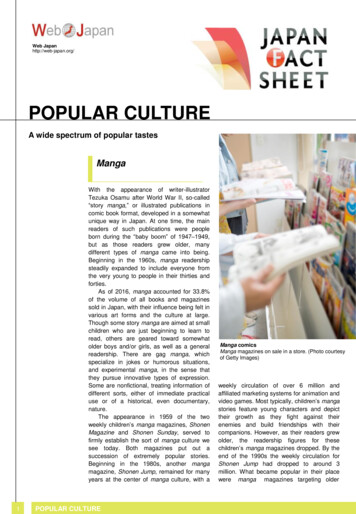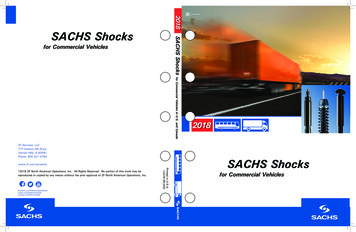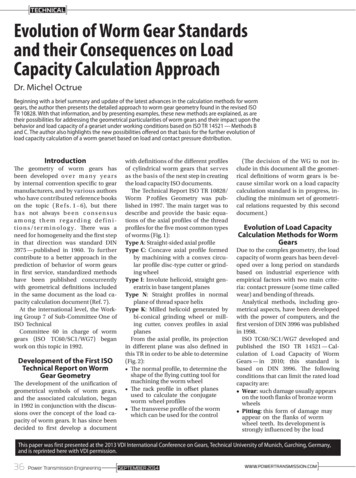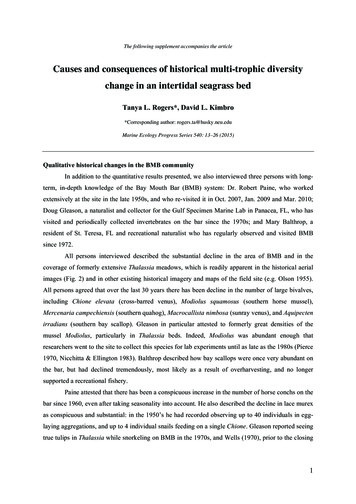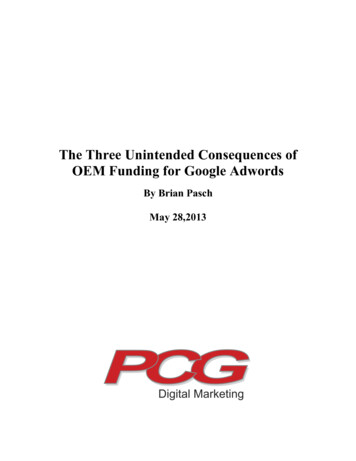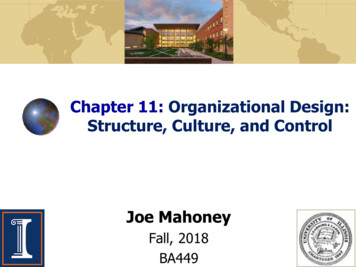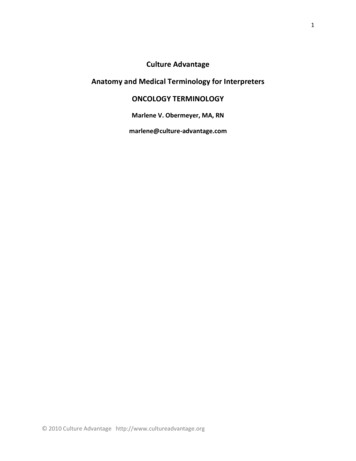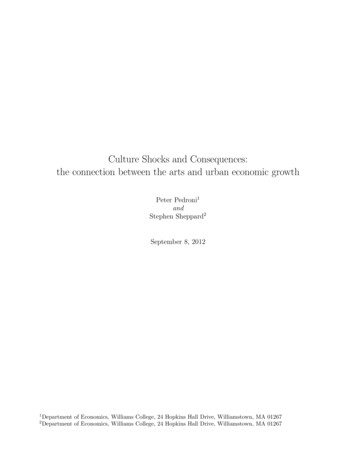
Transcription
Culture Shocks and Consequences:the connection between the arts and urban economic growthPeter Pedroni1andStephen Sheppard2September 8, 201212Department of Economics, Williams College, 24 Hopkins Hall Drive, Williamstown, MA 01267Department of Economics, Williams College, 24 Hopkins Hall Drive, Williamstown, MA 01267
AbstractIs there a relationship between local arts and culture production and local prosperity that is permanentrather than transitory? The answer to this question determines whether arts and culture productiongenerates economic growth or a temporary ‘multiplier’ effect that diminishes over time. We argue thatdespite the obvious public policy interest in the subject there has been no fully satisfactory empiricalanalysis of this question. In this paper we provide a model that allows us to think systematically about theproblem and an empirical methodology capable of testing relevant hypotheses concerning possible answersto the question. We identify data to which these methods can be applied, using per capita GDP andexpenditure levels of arts and culture production by not-for-profit organizations in US urban areas. Ouranalysis suggests that the impact of arts and culture production is not transitory. Shocks to local arts andculture production generate impacts that alter the local economy and change steady-state GDP.
1IntroductionDoes increasing the local production of arts and culture have a positive impact on the local economy?In some sense the answer to this question is obvious. Arts and culture production, like other types ofproduction, is part of the local economy and when it occurs inputs are purchased, artists and support staffare paid, and this activity is part of the local economy. What is less obvious is whether this impact persistsin the long run. Increased culture production will add to the local economy in the short run, but theeconomy is a dynamic and complex system that will respond to this change. An increase in available liveperforming arts programming may lead eventually to reduced attendance at carnivals or sporting events.More museums might eventually crowd out amusement parks or even shopping centers. The ability ofarts and culture production to generate a permanent increase in economic activity, or economic growth,is a question that is more subtle than asking whether such production has a positive impact on the localeconomy.Is there a relationship between local arts and culture production and local prosperity that is nottransitory, but permanent? The question is simple to state, and given the thousands of pages that havebeen written on the economic impact of the arts or the creative economy it might seem that finding asatisfactory answer would be a matter of sorting through a bibliographic database to select the best ofseveral analyses.We argue that despite the obvious public policy interest in the subject and the importance with whichthe question appears to be regarded, there has been no fully satisfactory empirical analysis of this question.We endeavor in what follows to provide a model that allows us to think systematically about the problemand an empirical methodology capable of testing relevant hypotheses concerning possible answers to thequestion. We identify data to which these methods can be applied, and carry out the analysis using datafor US urban areas.The idea of developing and supporting cultural sites and cultural organizations to promote economicprosperity is certainly not novel. Owen (1989) argues that the construction of cathedrals is an explanationfor growth of the European economy during the thirteenth century. Bercea, Ekelund & Tollison (2005),alternatively see such activities as a device for limiting competition in culture markets and religion.During the 1930s and early 1940s, the Works Progress Administration included public support forartists and writers alongside the building of roads, bridges and public buildings as activities worthy offunding. All of these activities were viewed as having a stimulative effect on the economy. While theartworks created through this program are highly prized today, there is little evidence concerning thecontribution their creation made to economic recovery.More recently, the United Nations Conference on Trade and Development (UNCTAD (2008)) hasprepared a comprehensive report describing what the authors called a ‘new paradigm’ in which cultureand creativity are ‘powerful engines driving economic growth and promoting development in a globalizingworld’. There is extensive data included with the report on international trade in cultural goods rangingfrom carpets to paintings, and discussions about the mechanisms for channeling public resources andinvestment into the cultural economy.The writers for the UN report assert that culture ‘drives’ economic growth, but the report itself offersscant evidence. The data provided demonstrate that arts and culture production is a significant economicsector employing large numbers of workers, generating large amounts of economic output and exportearnings. In this sense the report is similar to many studies of communities and regions in the US. Forexample, Lawton & Colgan (2011) survey the size, growth and distribution of arts and culture non-profitsand employment in the New England states. This report is part of a series of similar studies, sponsored bythe New England Foundation for the Arts, that began with Wassall (1997). These and other studies showthat culture production is a significant sector of the economy, and in many areas the size of this sector isgrowing. They do not, however, demonstrate that increasing the size of this sector leads to an increase ineconomic prosperity or per capita GDP in the urban area.Much of the interest in the topic during the past decade has been encouraged and actively promoted1
by the work of Richard Florida. In Florida (2002a), Florida (2002b), and Florida, Mellander & Stolarick(2008), inter alia he and his co-authors have analyzed what they see as the basis for economic growth anddevelopment. Florida’s writing itself insists on drawing attention not to specific industries or economicsectors like arts and culture production, but to specific occupational categories and types of workers thatare part of what he characterizes as the creative class. His writing goes out of its way to include “. poetsand novelists, artists, entertainers, actors .” as being among the “super creative core” of workers thatdrive economic growth. His work has been interpreted as supporting the notion that communities that areculturally active, diverse and provide a good environment for the arts will be economically successful.Unfortunately, there has been little evidence available to directly test this claim. Much of what has beenput forward has been unpersuasive for several reasons. First, much of the evidence consists of demonstratingthat culture production and the arts are a significant part of the economy. This line of inquiry concludesby showing that arts and culture production are a “multi-billion” dollar industry or some variation on thistheme. Frequently, in an effort to improve the result, the definition of which industries are part of thecultural economy will be expanded to include production of ancillary inputs or services that are peripheralto actual production of arts and cultural activities. Markusen, Wassall, DeNatale & Cohen (2008) providea useful comparison of such concepts and show that, depending on the definition used, the fraction of thelocal labor force engaged in cultural production or the creative economy can range from less than 1% tonearly half of the labor force. Whatever the size of the cultural economy, such evidence cannot demonstratethat a change in the size or level of support for this sector will cause an increase in economic prosperity.A second reason for such evidence being unpersuasive is that it fails to show that the impacts of cultureproduction is persistent. As noted above, it is clear that arts and culture production must contribute to theeconomy. What is not clear is whether this impact is persistent. If arts and culture production generatesa short run impact, but the impact simply crowds out other economic activities over time, there may bezero long run impact on the economy so that these impact studies are of very limited use. This point isnot a new revelation, and has been discussed by Seaman (1997).If the evidence presented so far has been inconclusive about the causal connection between arts andculture production and local economic prosperity, why do scholars and policy makers continue to pursuethese results? One reason is that there is a readily apparent correlation between culture production andlocal prosperity that can be measured by looking at cross-sectional data. Figure 1 shows the simple bivariaterelationship across US metropolitan areas between per capita GDP and per capita cultural organizationexpenditures.Even though this figure shows only the bivariate relation, there is a clear relationship suggesting thaturban areas with higher levels of per capita spending by cultural organizations tend also to have higher levelsof per capita GDP. If we couple this observation with arguments about how the arts and culture stimulatecreativity or attract and retain creative and productive workers, it can be presented as an argument insupport of the arts.A similar relationship, however, can be seen between many different types of economic activity andper capita local GDP. Figure 2 shows the apparent impact of increasing the activity of new car dealers (asmeasured by the per capita total payroll of new car dealers in the urban area). Here again we see a clearpositive relationship in the cross-section data. In this case the interpretation of the relationship that seemsmost reasonable is that communities with higher GDP will be likely to purchase more automobiles, andthis results in a larger automobile dealer sector 1 .Because the evidence put forward to date has not always been persuasive, public policies to support thearts have sometimes been controversial. Partly this controversy is related to a variety of political reasonsthat are not based on serious criticism of the evidence advanced in favor of the policies. Nevertheless, whenin the midst of the most severe recession in the US since the 1930s, members of Congress propose and1Many small communities expressed concern when, in the early days of the recession of 2008-2010 the major US automobilecompanies announced the closure of more than 3000 dealers. Nevertheless, few would argue that a policy of encouraging orsupporting more car dealers would promote economic growth.2
Figure 1: Relation between local GDP and cultural organization expendituresFigure 2: Relation between local GDP and automobile dealer payroll3
nearly pass a restriction prohibiting the use of stimulus funds for any art or cultural project, there mustbe some who support these restrictions because they believe that such spending will have zero stimulativeeffect on the economy, or believe that any effects will not contribute to a permanent increase in outputor employment. They may believe that such programs are analogous to policies designed to increase thesize and payroll of local automobile dealerships. While this would generate a short term boost in the localeconomy (because automobile dealers are part of the economy) it would be unlikely to generate a long termprocess of economic growth. Once the policy is implemented, other parts of the economy would adjust todampen and likely eliminate the short-term gains.A further concern about such policies is that they devote scarce resources to cultural facilities when thepayoff would be greater from investing in education, public infrastructure, or private sector initiatives thatwould be displaced by the spending on arts and culture. In an influential treatise McCarthy, Ondaatje,Zakaras & Brooks (2004) raise objections to focusing attention on evaluation of the economic (or other‘instrumental’) benefits of the arts, fearing that such analysis “. runs the risk of being discredited if otheractivities are better at generating the same effects .” They worry that failure to consider the opportunitycosts of devoting scarce resources to culture and the arts weakens the arguments of arts advocates andthey recommend broadening the approach taken by arts advocates to devote more emphasis on the moresubjective and difficult-to-verify intrinsic benefits of the arts. While this might make sense as a strategyfor arts advocacy, it begs the question of what is the real relationship between the arts and local economicprosperity.To better inform policy making, it is essential to test two central ideas. First, is there a causalconnection running from arts and culture production to economic prosperity? This is to be distinguishedfrom a connection that is merely a correlation and unlikely to be useful for economic policy. Second, is theconnection between arts and culture production and economic prosperity one that is not simply transitory?This addresses the extent to which the arts and culture sector is capable of generating economic growth.In what follows we offer a novel approach to answering both of these questions. We consider stochasticprocesses that generate shocks to culture production, and ask whether these shocks generate subsequentlong-term changes to local GDP. After developing a model to provide a framework for formal presentationof this question, we analyze data for US urban areas to determine the answer.2A simple model of culture and growthTo provide focus for our analysis and to guide the interpretation of our empirical results presented below,it will be helpful to have a theoretical framework. Towards this end we adapt the stylized growth modelpresented in Canning & Pedroni (2008), which itself is adapted from Barro (1990).In a simple growth model total income is a function of the capital and labor available to the economy.As discussed in the previous section, we want to analyze the impact of the arts and cultural activities onthe local economy. The availability of cultural amenities may work to increase the productivity of laborand capital, and thereby increase aggregate income in the economy. We assume that aggregate income attime t in a representative urban area, denoted Yt , depends on the capital Kt and labor Lt available in theurban area and the total cultural resources Ct . The relation between these is taken to be:Yt At · Kt α Ct β Lt 1 α β(1)The parameter At in equation 1 represents total factor productivity, and changes over time according4
to random shocks and a possible trend:ln(At ) at a0 σ · t εt(2)where: εt δ · εt 1 wtσ 00 δ 1wt I(0) and E[wt ] 0This structure allows the model to represent either an exogenous-growth type structure in which δ 1 andσ 0 or alternatively an endogenous growth approach where δ 1 and σ 0. While the central focus ofour inquiry is the capacity of spending on culture and the arts to generate long run changes in economicprosperity, our model does not assume this capacity exists and allows for economic growth to come fromother sources.Labor available to the economy grows at a rate that is constant but subject to random fluctuations: ln LLt 1 n nt 1(3)tnt I(0) and E[nt ] 0While in most cities the total resources devoted to culture is modest compared to the other sectors ofthe local economy, culture is not costless to provide to the community. It competes for scarce investmentresources that might otherwise be allocated to capital. We assume that culture claims a share τt of thelocal income that is not used for consumption. Let s · Yt equal private savings, the amount of income notused for consumption. Then culture Ct available in the urban area is given by:Ct 1 τt · s · Yt(4)τt τ µtτ 0µt I(0) and E[µt ] 0The parameters τ and µt are of central interest from a policy perspective. In the context of our model,asking whether cultural spending “causes” economic prosperity is asking whether transitory innovationsor “shocks” to µt (the cultural shocks to which we refer in the title) cause permanent changes in per capitaYt . If there does exist such a causal link between culture and economic prosperity, it is possible that therelationship may be an adverse one. If too many resources are being diverted to culture production – ifτ is “too large” in a sense to be made precise below, then positive shocks to culture µt 0 will havenegative long run impacts on per capita Yt . This could happen because spending on culture takes awayfrom investment in capital for the local economy.To better understand the relationship between income and cultural spending per capita, we can divideboth sides of equation 4 by the labor force and take the logarithm to obtain: Lt(5)ct 1 ln s yt ln (τ µt ) lnLt 1where we use lower-case letters to denote the natural log of the upper case variable expressed in per capitaterms, and we assume constant (or at least stationary) labor force participation rates so that we can usethe labor force at time t in lieu of the actual urban population. Applying the stochastic structure assumedin equation 3 and rearranging, we can write this as:ct 1 ln s n yt 1 ln (τ µt ) nt 1 yt5(6)
This demonstrates that if the natural log of per capita income is integrated of order one so that the firstdifference is stationary, then within an economy whose structure is represented by the model, the logarithmof per capita cultural spending will also have a unit root and will be cointegrated with per capita income.The economy must have savings equals investment plus culture provision, so that:Kt 1 (1 τt ) · s · Yt(7)The modeling approach we have adopted can represent funding of culture through multiple pathways.For funding of culture through private philanthropy, the parameter τt presented in equation 4 measuresthe share of total local savings that is diverted from other investments to fund cultural institutions. Forfunding of such institutions via the public sector, the parameter τt represents the magnitude of a ‘culturetax’ that is imposed on local income to fund these organizations.If we substitute equations 7 and 4 into 1 and divide through by labor Lt 1 to express aggregate regionalincome in per capita terms, we obtain: YL At 1 · sα β (1 τt )α τt β · t 1YLα β ·tLtLt 1 α β(8)Taking the logarithm of this per capita version of the model, we can write:yt 1 h (α β) · yt νt 1withh a0 σt (α β) · (ln(s) n)andνt 1 εt 1 α · ln (1 τ µt ) β · ln (τ µt ) (α β) · nt 1(9)The assumptions specified in equations 2, 3 and 4 imply that stochastic process that generates ηt 1 in9 is stationary but that the stochastic process for total factor productivity that generates εt 1 , is possiblynon-stationary depending on the value of δ. Notice that this, in turn, determines whether νt 1 is nonstationary. However the stochastic process describing yt 1 will always be non-stationary in the setupdescribed by our model.Canning & Pedroni (2008), who present a model identical to this in all essentials (but applied in amuch different context) show that if:δ 1 and α β 1(10)orδ 1 and α β 1(11)then the log of per capita income and log of per capita culture provision will each have a unit root and becointegrated so that for each city there will be a linear combination of yt and ct that is stationary. Theyfurther show that if condition 10 holds, then innovations in µt , here representing shocks to the provisionof culture and the arts to the local economy, will have no long run impact on prosperity as measured byyt . Alternatively if condition 11 holds, then shocks to local culture provision will have a non-zero longrun effect on per capita output yt . In this case there is a causal connection between arts and culture andeconomic prosperity.The ca
The data provided demonstrate that arts and culture production is a signi cant economic sector employing large numbers of workers, generat


